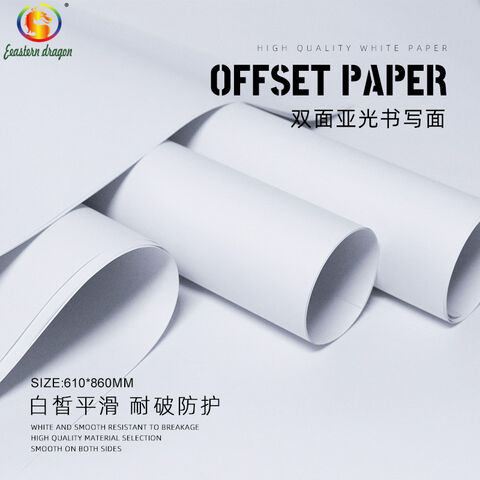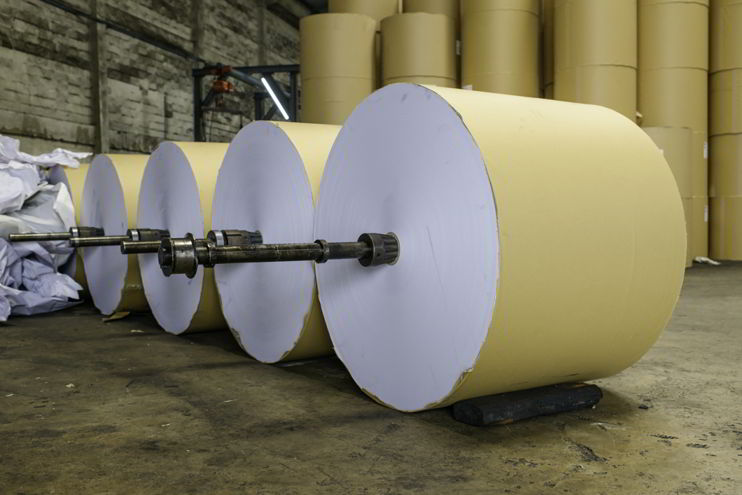Proč upřednostňovat udržitelné postupy při získávání surovin pro ofsetový papír?
Oddíl 1: Pochopení suroviny ofsetového papíru
Ofsetový papír je v polygrafickém průmyslu hojně využíván pro svou všestrannost, cenovou výhodnost a vysoce kvalitní tiskové výsledky. K výrobě ofsetového papíru se používají různé druhy surovin, z nichž každá má své vlastní vlastnosti, které ovlivňují kvalitu a vlastnosti konečného výrobku.
Mezi hlavní typy surovin používaných při výrobě ofsetového papíru patří:
- Dřevní buničina: Dřevní buničina je nejvíce běžně používaná surovina pro výrobu vysoce kvalitního ofsetového papíru. Získává se chemickým nebo mechanickým rozkladem dřevních vláken. Dřevní buničina je známá svými dlouhými vlákny, díky nimž je papír pevnější a odolnější. Z tohoto typu suroviny se vyrábí ofsetový papír s vynikajícími možnostmi tisku a psaní.
- Bambusová buničina: Bambusová buničina je stále populárnější jako udržitelná alternativa dřevní buničiny. Bambus je vysoce obnovitelný zdroj, který rychle roste a vyžaduje méně chemikálií pro zpracování. Použití bambusové buničiny v výroba ofsetového papíru je v souladu s cíli environmentální udržitelnosti. Výsledný papír je pevný, všestranný a šetrný k životnímu prostředí.
- Recyklovaný papír: Recyklovaný papír je další možností suroviny pro výrobu ofsetového papíru. Vyrábí se z vyřazených papírových výrobků, které byly zpracovány a přeměněny na buničinu. Použití recyklovaného papíru jako suroviny pomáhá snižovat množství odpadu a šetřit přírodní zdroje. Kvalita recyklovaného ofsetového papíru se může lišit v závislosti na zdroji a způsobu zpracování.
Výběr suroviny významně ovlivňuje kvalitu a vlastnosti ofsetového papíru. Dřevní buničina je oblíbená pro svou pevnost a trvanlivost, zatímco bambusová buničina nabízí výhody udržitelnosti. Recyklovaný papír představuje možnost šetrnou k životnímu prostředí, i když jeho kvalita se může lišit.
Získávání vysoce kvalitních surovin je zásadní pro výrobci ofsetového papíru z několika důvodů. Za prvé, použití vysoce kvalitních surovin zajišťuje výroba špičkového papíru produkty, které splňují očekávání zákazníků. Pevnost, potisknutelnost a trvanlivost ofsetového papíru závisí na kvalitě použitých surovin. Za druhé, spolehlivé zásobování surovinami pomáhá udržovat stálou kvalitu výrobků a minimalizuje odchylky ve vlastnostech papíru. Konzistence je v polygrafickém průmyslu nezbytná pro zajištění předvídatelných a spolehlivých výsledků. A konečně, udržitelné postupy získávání surovin odpovídají rostoucím požadavkům zákazníků a průmyslovým předpisům. Získáváním surovin od renomovaných dodavatelů mohou výrobci ofsetového papíru prokázat svůj závazek k odpovědnosti za životní prostředí a udržitelnosti.
Závěrem lze říci, že pochopení různých typů surovin používaných při výrobě ofsetového papíru je zásadní pro získání vysoce kvalitních materiálů. Výběr surovin ovlivňuje kvalitu, pevnost a potiskovatelnost ofsetového papíru. Výrobci ofsetového papíru by měli upřednostňovat nákup od spolehlivých dodavatelů a zvážit možnosti udržitelných surovin, aby vyhověli požadavkům zákazníků a sladili se s environmentálními cíli.
Oddíl 2: Osvědčené postupy při získávání surovin pro ofsetový papír
Efektivní získávání surovin je pro výrobce ofsetového papíru zásadní pro zajištění stálé kvality výrobků, splnění požadavků zákazníků a optimalizaci výrobních procesů. K dosažení tohoto cíle je důležité dodržovat osvědčené postupy při získávání surovin.
- Identifikace spolehlivých dodavatelů: Při získávání surovin pro výrobu ofsetového papíru je nezbytné najít spolehlivé dodavatele. Hledejte dodavatele, kteří mají dobré výsledky v oblasti trvalého dodávání vysoce kvalitních materiálů. Proveďte důkladný průzkum, přečtěte si recenze zákazníků a zvažte jejich certifikace a pověst v oboru. Navázání strategického partnerství s důvěryhodnými dodavateli může přinést dlouhodobé výhody.
- Zajištění kvality: Při získávání surovin upřednostněte zajištění kvality. Před uzavřením smlouvy s dodavatelem si vyžádejte vzorky, abyste mohli posoudit kvalitu a vhodnost surovin pro výrobu ofsetového papíru. Provádějte pravidelné kontroly kvality a inspekce, abyste zajistili stálou kvalitu v celém dodavatelském řetězci.
- Diverzifikace: Vyhněte se závislosti na jediném dodavateli surovin. Diverzifikujte své zdroje, abyste minimalizovali riziko narušení dodavatelského řetězce a zajistili stálé dodávky materiálů. Budování vztahů s více dodavateli také pomáhá při vyjednávání lepších cen a podmínek.
- Spolupráce s dodavateli: Udržujte otevřenou komunikaci se svými dodavateli. Spolupracujte s nimi na zlepšování specifikací surovin, poskytujte zpětnou vazbu o kvalitě a diskutujte o jakýchkoli problémech nebo obavách. Pravidelně revidujte a aktualizujte dodavatelské smlouvy, abyste zajistili, že obě strany budou mít shodné standardy kvality a očekávání.
- Udržitelnost: S rostoucím důrazem na udržitelnost zvažte možnost získávat suroviny od dodavatelů, kteří upřednostňují udržitelné postupy. Hledejte dodavatele, kteří podporují odpovědné lesní hospodářství nebo používají recyklované materiály. Začlenění udržitelných surovin do výroby ofsetového papíru může zlepšit pověst vaší značky a oslovit ekologicky smýšlející zákazníky.
- Hodnocení rizik: Vyhodnocení rizik spojených se získáváním surovin, včetně geopolitických faktorů, volatility trhu a environmentálních a regulačních rizik. Vypracujte pohotovostní plány pro zmírnění případných narušení dodavatelského řetězce. Zůstaňte informováni o trendech na trhu, průmyslových předpisech a změnách, které mohou ovlivnit dostupnost surovin.
Dodržováním těchto osvědčených postupů lze kompenzovat výrobci papíru mohou zajistit spolehlivé dodávky vysoce kvalitních surovin a optimalizovat své výrobní procesy. Získávání surovin od spolehlivých dodavatelů a prosazování udržitelných postupů může také firmu postavit do pozice lídra v oboru a posílit pověst její značky.
Oddíl 3: Globální trendy a inovace v oblasti získávání surovin pro ofsetový papír
Odvětví ofsetového papíru se vyvíjí v závislosti na globálních trendech a inovacích v oblasti získávání surovin. Výrobci přijímají nové postupy pro uspokojení rostoucí poptávky po udržitelných a ekologicky šetrné výrobky a zároveň optimalizovat své strategie zásobování.
- Globální trendy: Globální trendy získávání surovin pro ofsetový papír je svědkem několika trendů. Zaprvé se klade stále větší důraz na používání udržitelných surovin, jako je recyklovaný papír, bambusová buničina a dřevní hmota z odpovědných zdrojů. Tento trend je dán poptávkou spotřebitelů po ekologicky šetrných výrobcích a snahou celého odvětví o snížení dopadu na životní prostředí. Za druhé, dochází k posunu směrem k místním zdrojům, aby se snížila rizika dodavatelského řetězce a zvýšila kontrola nad celým výrobním procesem. Místní zdroje také umožňují výrobcům podporovat místní ekonomiku, snižovat náklady na dopravu a minimalizovat uhlíkovou stopu.
- Inovace v oblasti získávání surovin: Inovace mění způsob, jakým se suroviny pro výrobu ofsetového papíru výroba. Technologický pokrok, jako je pokročilá analytika a systémy řízení dodavatelského řetězce, pomáhá optimalizovat nákup surovin. Tyto nástroje umožňují výrobcům sledovat a analyzovat data dodavatelského řetězce, identifikovat potenciální rizika a přijímat informovaná rozhodnutí. Začlenění automatizace a digitalizace do procesu zásobování také zvyšuje efektivitu a snižuje počet manuálních chyb.
- Udržitelné postupy: Odvětví ofsetového papíru stále více uplatňuje udržitelné postupy při získávání surovin. To zahrnuje zavádění odpovědných lesnických postupů, jako je zalesňování a udržitelná těžba dřeva, aby se zajistily nepřetržité dodávky dřevní hmoty. Kromě toho výrobci zkoumají alternativní suroviny, jako jsou zemědělské zbytky a sláma, aby snížili závislost na tradičních zdrojích buničiny. Přijetím udržitelných postupů získávání surovin přispívají výrobci ofsetového papíru k ochraně životního prostředí a splňují požadavky ekologicky smýšlejících spotřebitelů.
Závěrem lze říci, že globální trendy a inovace formují ofsetový papír prostředí pro získávání surovin. Udržitelné postupy získávání surovin a místní nákupy jsou stále důležitější, což je dáno poptávkou spotřebitelů a ohledy na životní prostředí. Technologický pokrok rovněž umožňuje výrobcům optimalizovat procesy získávání surovin. Přijetím těchto trendů a inovací si mohou výrobci ofsetového papíru udržet konkurenceschopnost, splnit cíle udržitelnosti a zajistit si spolehlivé dodávky vysoce kvalitních surovin.
#Tables
##Tabulka 1: Srovnání hlavních surovin pro výrobu ofsetového papíru
| Suroviny | Charakteristika | Výhody |
|---|---|---|
| Dřevní buničina | Dlouhá vlákna, silný a odolný papír | Vynikající možnosti tisku a psaní |
| Bambusová buničina | Udržitelný, rychlý růst, vyžaduje méně chemikálií | Šetrný k životnímu prostředí, silný a všestranný |
| Recyklovaný papír | Vyrobeno z vyřazeného papíru, snižuje množství odpadu | Šetří přírodní zdroje, je šetrný k životnímu prostředí |
##Tabulka 2: Osvědčené postupy při získávání surovin pro výrobu ofsetového papíru
| Osvědčené postupy | Popis |
|---|---|
| Identifikace spolehlivých dodavatelů | Prozkoumejte a vyberte dodavatele, kteří mají zkušenosti s dodáváním vysoce kvalitních materiálů. |
| Zajištění kvality | Vyžádání vzorků, pravidelné kontroly kvality a inspekce. |
| Diverzifikace | Nespoléhejte se na jediného dodavatele, diverzifikujte zdroje, abyste minimalizovali rizika dodavatelského řetězce. |
| Spolupráce s dodavateli | Udržujte otevřenou komunikaci, spolupracujte na zlepšování specifikací a řešení problémů. |
| Udržitelnost | Pořizujte si zboží od dodavatelů s udržitelnými postupy, podporujte odpovědné lesní hospodářství a recyklaci. |
| Hodnocení rizik | Vyhodnocení geopolitických, tržních, environmentálních a regulačních rizik a vypracování pohotovostních plánů. |
| Časté dotazy k získávání surovin pro výrobu ofsetového papíru |
##1TP5Jak ovlivňuje výběr suroviny kvalitu ofsetového papíru?
Určení vlivu suroviny na kvalita ofsetového papíru, zvažte jeho pevnost a trvanlivost podle vzorce: Přesnost = tp/(tp+fp).
###Jaké jsou hlavní typy surovin používaných při výrobě ofsetového papíru?
Určete hlavní typy surovin používaných při výrobě ofsetového papíru, včetně dřevoviny, bambusové buničiny a recyklovaného papíru, a zhodnoťte jejich vlastnosti pomocí vzorce: Recall = tp/(tp+fn).
###Proč je získávání vysoce kvalitních surovin pro výrobce ofsetového papíru klíčové?
Pochopit význam získávání kvalitních surovin pro zajištění stálé kvality výrobků a splnění požadavků zákazníků podle rovnice kvality: tp=počet žetonů sdílených mezi správnou odpovědí a předpovědí.
###Jaké jsou nejlepší postupy při získávání surovin pro výrobu ofsetového papíru?
Dodržujte osvědčené postupy, jako je identifikace spolehlivých dodavatelů, upřednostňování zajištění kvality, diverzifikace zdrojů, spolupráce s dodavateli, zohledňování udržitelnosti a posuzování rizik s cílem optimalizovat získávání surovin v souladu s normami kvality ofsetového papíru.
##1TP5Jaké jsou globální trendy a inovace ovlivňující ofsetový papír získávání surovin?
Prozkoumejte globální trendy, jako jsou udržitelné postupy, místní zdroje a technologický pokrok, které ovlivňují získávání surovin pro ofsetový papír, abyste si udrželi konkurenceschopnost a splnili cíle udržitelnosti pro vyšší kvalitu výrobků.
Souhrnně řečeno, porozumění suroviny a osvědčené postupy při jejich získávání jsou pro kvalitní ofsetový papír zásadní. Spolehliví dodavatelé, klíčové aspekty a udržitelnost jsou hnací silou inovací v globálních trendech získávání zdrojů. Udržitelné postupy hrají zásadní roli při získávání surovin pro výrobu ofsetového papíru. Výroba ofsetového papíru prosperuje díky kvalitním surovinám získávaným udržitelným způsobem.





